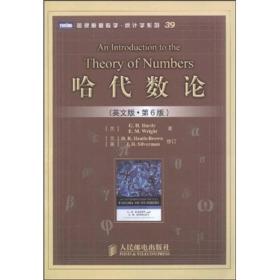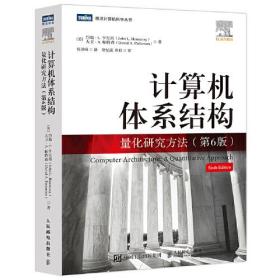
哈代数论(英文版·第6版)
华罗庚的老师,英国著名数学家的传世经典,这是第6版,书名为数论导引的是第5版,请注意区分
¥ 450 九品
仅1件
吉林辽源
认证卖家担保交易快速发货售后保障
作者哈代(G.H.Hardy)、哈代(G.H.Hardy) 著
出版社人民邮电出版社
出版时间2009-11
版次1
装帧平装
上书时间2021-03-11
- 在售商品 暂无
- 平均发货时间 2小时
- 好评率 暂无
- 最新上架
商品详情
- 品相描述:九品
图书标准信息
- 作者 哈代(G.H.Hardy)、哈代(G.H.Hardy) 著
- 出版社 人民邮电出版社
- 出版时间 2009-11
- 版次 1
- ISBN 9787115214270
- 定价 59.00元
- 装帧 平装
- 开本 32开
- 纸张 胶版纸
- 页数 621页
- 字数 576千字
- 正文语种 英语
- 丛书 图灵原版数字·统计学系列
- 【内容简介】
-
《哈代数论(英文版·第6版)》是数论领域的一部传世名著,成书于作者在牛津大学、剑桥大学等学校授课的讲义。书中从各个不同角度对数论进行了阐述,内容包括素数、无理数、同余、费马定理、连分数、不定式、二次域、算术函数、分化等。新版修订了每章末的注解,简要介绍了数论最新的发展;增加了一章讲述椭圆曲线,这是数论中最重要的突破之一。还列出进一步阅读的文献。
《哈代数论(英文版·第6版)》适合数学专业本科生、研究生和教师用作教材或参考书,也适合对数论感兴趣的专业人士阅读参考。 - 【作者简介】
-
G.H.Hardy(1877-1947),20世纪上半叶享有世界声誉的数学大师,是英国数学界和英国分析学派的领袖,对数论和分析学的发展有巨大的贡献和重大的影响,除了自己的研究工作之外,他还培养和指导了众多数学大家,包括印度数学奇才拉马努金和我国数学家华罗庚。
E.M.Wright(1906-2005),英国著名数学家,毕业于牛津大学,是G.H.Hardy的学生。生前担任英国名校阿伯丁大学校长多年。爱丁堡皇家学会会士、伦敦数学会会士。曾任JournalofGraphTheory和ZentralbtattfurMathematik的名誉主编。 - 【目录】
-
Ⅰ.THESERIESOFPRIMES(1)
1.1.Divisibilityofintegers
1.2.Primenumbers
1.3.Statementofthefundamentaltheoremofarithmetic
1.4.Thesequenceofprimes
1.5.Somequestionsconcerningprimes
1.6.Somenotations
1.7.Thelogarithmicfunction
1.8.Statementoftheprimenumbertheorem
Ⅱ.THESERIESOFPRIMES(2)
2.1.FirstproofofEuclidssecondtheorem
2.2.FurtherdeductionsfromEuclidsargument
2.3.Primesincertainarithmeticalprogressions
2.4.SecondproofofEuclidstheorem
2.5.FermatsandMersennesnumbers
2.6.ThirdproofofEuclidstheorem
2.7.Furtherresultsonformulaeforprimes
2.8.Unsolvedproblemsconcerningprimes
2.9.Moduliofintegers
2.10.Proofofthefundamentaltheoremorarithmetic
2.11.Anotherproofofthefundamentaltheorem
Ⅲ.FAREYSERIESANDATHEOREMOFMINKOWSKI
3.1.ThedefinitionandsimplestpropertiesofaFareyseries
3.2.Theequivalenceofthetwocharacteristicproperties
3.3.FirstproofofTheorems28and
3.4.Secondproofofthetheorems
3.5.Theintegrallattice
3.6.Somesimplepeopertiesofthefundamentallattice
3.7.ThirdproofofTheorems28and
3.8.TheFarevdissectionofthecontinuum
3.9.AtheoremofMinkowski
3.10ProofofMinkowskistheorem
3.11.DevelopmentsofTheorem
Ⅳ.IRRATIONALNUMBERS
4.1.Somegeneralities
4.2.Numbersknowntobeirrational
4.3.ThetheoremofPythagorasanditsgeneralizations
4.4.TheuseofthefundamentaltheoremintheproofsofTheorems43-
4.5.Ahistoricaldigression3o
4.6.Geometricalproofoftheirrationalityof√
4.7.Somemoreirrationalnumbers
Ⅴ.CONGRUENCESANDRESIDUES
5.1.Highestcommondivisorandleastcommonmultiple
5.2.Congruencesandclassesofresidues
5.3.Elementaryorooertiesofcongruences
5.4.Linearcongruences
5.5.Eulersfunctionφ(m)
5.6.AoolicationsofTheorems59and61totrigonometricalsums
5.7.Ageneralprinciple
5.8.Constructionoftheregularpolygonof17sides
Ⅵ.FFRMATsTHEOREMANDITSCONSEOUENCES
6.1.Fermatstheorem
6.2.Somepropertiesofbinomialcoefficients
6.3.AsecondproofofTheorem
6.4.ProofofTheorem
6.5.Quadraticresidues
6.6.SoecialcasesofTheorem79:Wilsonstheorem
6.7.Elementarypropertiesofquadraticresiduesandnon-residues
6.8.Theorderofa(modm)IslS
6.9.TheconverseofFermatstheorem
6.10.Divisibilityof2P-1_1byp
6.11.Gaussslemmaandthequadraticcharacterof
6.12.Thelawofreciprocity
6.13.Proofofthelawofreciprocity
6.14.Testsfororimalitv
6.15.FactorsofMersennenumbers;atheoremofEuler
Ⅶ.GENERALPROPERTIESOFCONGRUENCES
7.1.Rootsofcongruences
7.2.Integralpolynomialsandidenticalcongruences
7.3.Divisibilityofpolynomials(modm)
7.4.Rootsofc~nmuencestoaorimemodulus
7.5.Someapplicationsofthegeneraltheorems
7.6.LagrangesproofofFermatsandWilsonstheorems
7.7.Theresidueof{1/2(p-1)}!
7.8.AtheoremofWolstenholme
7.9.ThetheoremofvonStaudt
7.10.ProofofvonStaudtstheorem
Ⅷ.CONGRUENCESTOCOMPOSITEMODULI
8.1.Linearcongruences
8.2.Congruencesofhigherdegree
8.3.Congruencestoaorime-oowermodulus
8.4.Examoles
8.5.Bauersidenticalcongruence
8.6.Bauerscongruence:thecasep=
8.7.AtheoremofLeudesdorf
8.8.FurtherconsequencesofBauerstheorem
8.9.Theresiduesof2P-1and(p-1)!tomodulusp
Ⅸ.THEREPRESENTATIONOFNUMBERSBYDECIMALS
9.1.Thedecimalassociatedwithagivennumber
9.2.Terminatingandrecurringdecimals
9.3.Representationofnumbersinotherscales
9.4.Irrationalsdefinedbydecimals
9.5.Testsfordivisibility
9.6.Decimalswiththemaximumperiod
9.7.Bachetsproblemoftheweights
9.8.ThegameofNim
9.9.Integerswithmissingdigits
9.10.Setsofmeasurezero
9.11.Decimalswithmissingdigits
9.12.Normalnumbers
9.13.Proofthatalmostallnumbersarenormal
Ⅹ.CONTINUEDFRACTIONS
10.1.Finitecontinuedfractions
10.2.Convementstoacontinuedfraction
10.3.Continuedfractionswithpositivequotients
10.4.Simplecontinuedfractions
10.5.Therepresentationofanirreduciblerationalfractionbyasimplecontinuedfraction
10.6.ThecontinuedfractionalgorithmandEuclidsalgorithm
10.7.Thedifferencebetweenthefractionanditsconvergents
10.8.Infinitesimplecontinuedfractions
10.9.Therepresentationofanirrationalnumberbyaninfinitecontinuedfraction
10.10.Alemma
10.11.Equivalentnumbers
10.12.Periodiccontinuedfractions
10.13.SomesoecialQuadraticsurds
10.14.TheseriesofFibonacciandLucas
10.15.Approximationbyconvergents
Ⅺ.APPROXIMATIONOFIRRATIONALSBYRATIONALS
11.1.Statementoftheoroblem
11.2.Generalitiesconcerningtheproblem
11.3.AnargumentofDirichlet
11.4.Ordersofaporoximation
11.5.Aloohrnienncltranscendentalnumbers
11.6.Theexistenceoftranscendentalnumbers..
11.7.Liouvillestheoremandtheconstructionoftranscendentalnumbers
11.8.Themeasureoftheclosestapproximationstoanarbitraryirrational
11.9.Anothertheoremconcerningtheconvergentstoacontinuedfraction
11.10.Continuedfractionswithboundedquotients
11.11.Furthertheoremsconcerningapproximation
11.12.Simultaneousapproximation
11.13.Thetranscendenceofe
11.14.Thetranscendenceofπ
Ⅻ.THEFUNDAMENIALTHEOREMOFARITHMETICINk(1),k(i),ANDk(O)
12.1.Algebraicnumbersandintegers
12.2.Therationalintegers,theGaussianintegers,andtheintegersofk(p)
12.3.Euclidsalgorithm
12.4.AoolicationofEuclidsalgorithmtothefundamentaltheoremink(1)
12.5.HistoricalremarksonEuclidsalgorithmandthefundamentaltheorem
12.6.ProoertiesoftheGaussianintegers
12.7.Primesink(i)
12.8.Thefundnmentaltheoremofarithmeticink(i)
12.9.Theintegersofk(p)
ⅩⅢ.SOMEDIOPHANTINEEQUATIONS
13.1.Fermatslasttheorem
13.2.Theeauationxz4-vz=zz
13.3.Theequationx4-t-y4=z
13.4.Theequationx3+y3=z
13.5.Theequationx3+y3=3z
13.6.Theexoressionofarationalasasumofrationalcubes
13.7.Theequationx3+y3+z3=t
ⅩⅣ.OUADRATICFIELDS(1)
14.1.Algebraicfields
14.2.Algebraicnumbersandintegers:orimitivepolynomials
14.3.Thegeneralquadraticfieldk(√m)
14.4.Unitiesandorimes
14.5.Theunitiesofk(√2)
14.6.Fieldsinwhichthefundamentaltheoremisfalse
14.7.ComnlexEuclideanfields
14.8.RealEuclideanfields
14.9.RealEuclideanfields(continued)
ⅩⅤ.OUADRATICFIELDS(2)
15.1.Theorimesofk(i)
15.2.Fermatstheoremink(i)
15.3.Theprimesofk(p)
15.4.Theprimesofk(√2)andk(√5)
15.5.LucasstestfortheprimalityoftheMersennenumberM4n+
15.6.Generalremarksonthearithmeticofquadraticfields
15.7.Idealsinaquadraticfield
15.8.Otherfields
ⅩⅥ.THEARITHMETICALFUNCTIONSФ(n),μ(n),d(n),σ(n),r(n)
16.1.ThefunctionФ(n)
16.2.AfurtherproofofTheorem
16.3.TheMrbiusfunction
16.4.TheMrbiusinversionformula
16.5.Furtherinversionformulae
16.6.EvaluationofRamanuianssum
16.7.Thefunctionsd(n)andcrk(n)
16.8.Perfectnumbers
16.9.Thefunctionr(n)
16.10.Proofoftheformulaforr(n)
ⅩⅦ.GENERATINGFUNCTIONSOFARITHMETICALFUNCTIONS
17.1.ThegenerationofarithmeticalfunctionsbymeansofDirichletseries
17.2.Thezetafunction
17.3.Thebehaviourofξ(s)whens→
17.4.MultiplicationofDirichletseries
17.5.Thegeneratingfunctionsofsomespecialarithmeticalfunctions32~
17.6.TheanalyticalinterpretationoftheM6biusformula
17.7.ThefunctionA(n)
17.8.Furtherexamplesofgeneratingfunctions
17.9.Thegeneratingfunctionofr(n)
17.10.Generatingfunctionsofothertypes
ⅩⅧ.THEORDEROFMAGNITUDEOFARITHMETICALFUNCTIONS
18.1.Theorderofd(n)
18.2.Theaverageorderofd(n)
18.3.Theorderofσ(n)
18.4.TheorderofФ(n)
18.5.TheaverageorderofФ(n)
18.6.Thenumberofsquarefreenumbers
18.7.Theorderofσ(n)
ⅩⅨ.PARTITIONS
19.1.Thegeneralproblemofadditivearithmetic
19.2.Partitionsofnumbers
19.3.Thegeneratingfunctionofp(n)
19.4.Othergeneratingfunctions
19.5.TwotheoremsofEuler
19.6.Furtheralgebraicalidentities
19.7.AnotherformulaforF(x)
19.8.AtheoremofJacobi
19.9.SpecialcasesofJacobisidentity
19.10.ApplicationsofTheorem
19.11.ElementaryproofofTheorem
19.12.Congruencepropertiesofp(n)
19.13.TheRogers-Ramanujanidentities
19.14.ProofofTheorems362and
19.15.Ramanujanscontinuedfraction
ⅩⅩ.THEREPRESENTATIONOFANUMBERBYTWOORFOURSQUARES
20.1.Waringsproblem:thenumbersg(k)andG(k)
20.2.Squares
20.3.SecondproofofTheorem
20,4.ThirdandfourthproofsofTheorem
20.5.Thefour-squaretheorem
20.6.Quaternions
20.7.Preliminarytheoremsaboutintegralquatemions
20.8.Thehighestcommonfight-handdivisoroftwoquatemions
20.9.PrimequatemionsandtheproofofTheorem
20.10.Thevaluesofg(2)andG(2)
20.11.LemmasforthethirdproofofTheorem
20.12.ThirdproofofTheorem369:thenumberofrepresentations
20.13.Representationsbyalargernumberofsquares
ⅩⅩⅠ.REPRESENTATIONBYCUBESANDHIGHERPOWERS
21.1.Biquadrates
21.2.Cubes:theexistenceofG(3)andg(3)
21.3.Aboundforg(3)
21.4.Higherpowers
21.5.Alowerboundforg(k)
21.6.LowerboundsforG(k)
21.7.Sumsaffectedwithsigns:thenumberv(k)
21.8.Upperboundsforv(k)
21.9.TheproblemofProuhetandTarry:thenumberP(k,j)
21.10.EvaluationofP(k,j)forparticularkandj
21.11.FurtherproblemsofDiophantineanalysis
ⅩⅩⅡ.THESERIESOFPRIMES(3)
22.1.Thefunctions0(x)and$(x)
22.2.Proofthat0(x)and~(x)areoforderx
22.3.Bertrandspostulateandaformulaforprimes
22.4.ProofofTheorems7and
22.5.Twoformaltransformations
22.6.Animportantsum
22.7.Thesum12p~1andtheproductFI(1-p-1)
22.8.Mertensstheorem
22.9.ProofofTheorems323and
22.10.Thenumberofprimefactorsofn
22.11.Thenormalorderofto(n)andf2(n)
22.12.Anoteonroundnumbers
22.13.Thenormalorderofd(n)
22.14.Selbergstheorem
22.15.ThefunctionsR(x)andV(ξ)
22.16.CompletionoftheproofofTheorems434,6,and
22.17.ProofofTheorem
22.18.Productsofkprimefactors
22.19.Primesinaninterval
22.20.Aconjectureaboutthedistributionofprimepairsp,p+
ⅩⅩⅢ.KRONECKERSTHEOREM
23.1.Kroneckerstheoreminonedimension
23.2.Proofsoftheone-dimensionaltheorem
23.3.Theproblemofthereflectedray
23.4.Statementofthegeneraltheorem
23.5.Thetwoformsofthetheorem
23.6.Anillustration
23.7.Lettenmeyersproofofthetheorem
23.8.Estermannsproofofthetheorem
23.9.Bohrsproofofthetheorem
23.10.Uniformdistribution
ⅩⅩⅣ.GEOMETRYOFNUMBERS
24.1.Introductionandrestatementofthefundamentaltheorem
24.2.Simpleapplications
24.3.ArithmeticalproofofTheorem
24.4.Bestpossibleinequalities
24.5.Thebestpossibleinequalityforξ2+n
24.6.Thebestpossibleinequalityfor|ξn|
24.7.Atheoremconcerningnon-homogeneousforms
24.8.ArithmeticalproofofTheorem
24.9.Tchebotarefstheorem
24.10.AconverseofMinkowskisTheorem
ⅩⅩⅤ.ELLIPTICCURVES
25.1.Thecongruentnumberproblem
25.2.Theadditionlawonanellipticcurve
25.3.Otherequationsthatdefineellipticcurves
25.4.Pointsoffiniteorder
25.5.Thegroupofrationalpoints
25.6.Thegroupofpointsmodulop.
25.7.Integerpointsonellipticcurves
25.8.TheL-seriesofanellipticcurve
25.9.Pointsoffiniteorderandmodularcurves
25.10.EllipticcurvesandFermatslasttheorem
APPENDIX
1.Anotherformulaforpn
2.AgeneralizationofTheorem
3.Unsolvedproblemsconcerningprimes
ALISTOFBOOKS
INDEXOFSPECIALSYMBOLSANDWORDS
INDEXOFNAMES
GENERALINDEX
点击展开
点击收起
— 没有更多了 —












以下为对购买帮助不大的评价